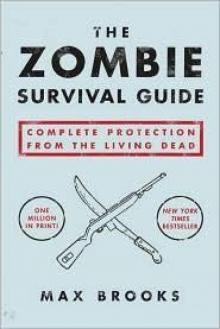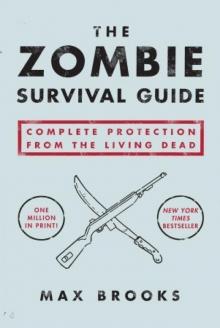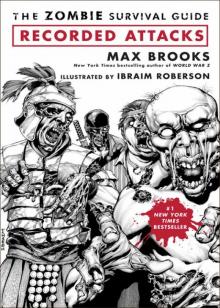- Home
- Max Brooks
The Zombie Survival Guide: Complete Protection From the Living Dead Page 10
The Zombie Survival Guide: Complete Protection From the Living Dead Read online
Page 10
7.
REMAIN MOBILE: Once discovered, zombies will converge on you from every direction. Mobility, not firepower, is your best defense. Be prepared to run at a moment’s notice. Never pack more than you can run with. Never unpack all your gear at once. Never remove your shoes unless immediate security is assured! Pace yourself. Undertake high-speed dashes only when necessary, as they squander large amounts of precious energy. Take frequent, short breaks. Do not allow yourself to become too comfortable. Remember to stretch during each break. Never take unnecessary risks. Jumping, climbing, and anything that could cause injury should be avoided if possible. In ghoul-infested territory, the last thing you need is a sprained ankle.
8.
REMAIN INVISIBLE: Other than speed, your next closest ally will be stealth. Like a mouse trying to crawl through a nest of snakes, you must do everything possible to avoid detection. Turn off any hand-held radios or electronic equipment. If you wear a digital watch, make sure the alarm is deactivated. Tie down all your gear, making sure nothing clanks when you walk. If possible, keep your canteen full (to avoid a “sloshing” sound). If in a group, refrain from talking. Whisper or use visual signals to communicate. Stick to areas with good cover. Travel through open areas only when necessary. At night, refrain from using fires, flashlights, or any other sources of light. This will restrict your mobility to daylight hours and your diet to cold rations, but these sacrifices must be made. Studies have shown that zombies with intact eyes can spot a glowing cigarette ember from over half a mile away. (It is not known whether this causes them to investigate, but why take the chance?)
Fight only when you have to. Delays brought on by battle will serve only to draw more zombies. People have been known to finish off one zombie only to find themselves surrounded by dozens more. If combat proves inevitable, use firearms only in the most desperate of circumstances. Firing a shot is no different than sending up a flare. Its report may attract zombies for miles around. Unless you have a reliable and very speedy means of escape, or unless your firearm is silenced, use a secondary hand weapon. If not, have an escape route planned and ready to use once your shots are fired.
9.
LOOK AND LISTEN: In addition to staying hidden, you must try to spot potential threats. Watch for any movement. Don’t ignore shadows or distant humanoid forms. During breaks and while on the march, pause to listen to your surroundings. Do you hear footsteps or scraping sounds? Are the undead moaning, or is it just the wind? Of course, it is easy to become paranoid, to believe zombies are around every corner. Is that bad? In this instance, no. It’s one thing to believe everyone’s out to get you, quite another when it’s actually true.
10.
SLEEP!: You or your group are all alone, trying to be silent, trying to be alert. Zombies could be anywhere, hiding, hunting. Dozens could appear at any moment, and help is miles away. So how in heaven’s name are you supposed to get any sleep!?! It sounds crazy, it sounds impossible, but it is essential if you’re going to make it through this ordeal alive. Without rest, muscles deteriorate, senses dull, and each passing hour reduces your ability to operate. Many a foolhardy human, believing he could load his body with caffeine and “power through” his trek, has realized too late the consequences of such stupidity. One advantage of having to travel by day is that, like it or not, you’re not going anywhere for at least several hours. Instead of cursing the darkness, use it. Traveling in small groups, as opposed to solo, allows for more secure sleep because individual members can take shifts standing watch. Of course, even with someone watching over you, dropping off will not be easy. Resist the temptation of sleeping pills. Their effects could leave you unable to function if zombies attack during the night. Other than meditation or other mental exercises, there is no quick fix for getting to sleep in the middle of an infestation.
11.
REFRAIN FROM OVERT SIGNALS: The first sight of a plane might cause you to try to attract the pilot’s attention, firing your weapon, sending up a flare, lighting a signal fire, or by some other dramatic means. This could get the pilot’s attention, who could radio for a helicopter or ground rescue team to head for your position. This act will also attract nearby zombies. Unless the helicopter is only minutes away, the zombies will undoubtedly reach you first. Unless the aircraft you see has the potential to land right then and there, do not attempt to signal it with anything other than a radio or mirror. If these are not available, keep going.
12.
AVOID URBAN AREAS: No matter what your chances for survival are during an infestation, they will undoubtedly drop by 50 if not 75 percent when traversing an urban area. The simple fact is that a place inhabited by more living will have more dead. The more buildings present, the more places to be ambushed. These buildings also decrease your field of vision. Hard cement surfaces, unlike soft ground, do nothing to muffle footsteps. Add to that the chances of simply knocking something over, tripping over debris, or crunching over broken glass, and you have a recipe for a very noisy trip.
Also, as has been and will be stressed again in this chapter, the possibility of being trapped, cornered, or otherwise surrounded in an urban area is infinitely greater than it is in any wilderness setting. Forget for a moment that your problem even comes from the living dead. What about friendly fire, other humans hiding in buildings, or armed bands of hunters that mistake you for a zombie? What about fire, either accidental or intentionally started by hunters? What about chemical spills, poisonous smoke, or other hazardous by-products of urban warfare? What about disease? Remember that bodies of both dead humans and dispatched zombies might be left unattended for weeks. The deadly microorganisms they carry that are spread by the wind will be as potent a health hazard as any other found on city streets. Unless you have some legitimate reason (a rescue attempt or impassable obstacles on either side, not a quick chance to loot), stay away from cities at all costs!
EQUIPMENT
Traveling light is essential to your journey. Before packing anything, ask yourself, “Do I really need this?” Once you’ve compiled your gear, go down the list and ask that question again. Once you’ve done that, do it again. Of course, traveling light does not mean just holstering a .45, grabbing some beef jerky and a water bottle, and heading down the road. Equipment will be vital, more so than in any other scenario where you are holed up in a place—a prison, a school, your own home—where supplies are in abundance. The equipment you take with you may be all you have. You will carry your hospital, storeroom, and armory on your back. The following is a list of standard equipment you will need for a successful journey. Specific gear such as alpine skis, sunblock, or mosquito netting should be added according to your environment.
•
Backpack
•
Dependable hiking boots (already broken in)
•
Two pairs of socks
•
Wide-mouthed, quart-sized water bottle
•
Water-purification tablets*
•
Wind- and waterproof matches
•
Bandanna
•
Map**
•
Compass**
•
Small flashlight (AAA battery) with coated lens
•
Poncho
•
Small signaling mirror
•
Bedroll or sleeping bag (both will be too cumbersome)
•
Sunglasses (polarized lenses)
•
Palm-sized first-aid kit*
•
Swiss Army knife or multi-tool
•
Hand-held radio with earpiece**
•
Knife
•
Binoculars**
•
Primary firearm (preferably, a semiautomatic carbine)
•
Fifty rounds (if in a group, thirty per person)
�
�
Cleaning kit**
•
Secondary firearm (preferably a .22 rimfire pistol)*
•
Twenty-five rounds*
•
Hand weapon (preferably, a machete)
•
Signal flares**
*not necessary in groups
**need be carried by only one person if in a group
In addition, all groups should carry:
•
Silent ballistic weapon (preferably a silenced firearm or crossbow)
•
Extra ammunition for fifteen kills (if weapon differs from standard firearm)
•
Telescopic sight
•
Medium-sized medical kit
•
Two-way radio with headphones
•
Crowbar (in lieu of hand weapon)
•
Water-purification pump
Once you have chosen your gear, make sure everything works. Try it all, over and over again. Wear your backpack for an entire day. If the weight is too much in the comfort of your fortress, imagine how it will feel after a daylong hike. Some of these problems can be solved by choosing objects that combine various tools (some portable radios come equipped with flashlights, survival knives carry compasses, etc.). Apply this space-saving philosophy when choosing weapons as well. A silencer for an existing weapon requires less space than a whole new weapon, such as a crossbow and extra bolts. Wearing your pack for a day will also give you an idea where the chafe points are, where the harness needs adjusting, and how best to secure the gear.
VEHICLES
Why walk when you could ride? Americans have always been obsessed with the idea of labor-saving machinery. In all walks of life, industry struggles in an endless race to invent and perfect machines that make the chores of everyday life faster, easier, and more efficient. And what could be a greater deity of American techno-religion than the automobile? No matter what our age, gender, race, economic status, or geographic location, we are taught that this omnipotent machine, in all of its wondrous forms, is the answer to our prayers. Why wouldn’t this be true during a zombie outbreak? Wouldn’t it make sense to just race across hostile ground? Travel time would be reduced from days to mere hours. Equipment storage would no longer be a problem. And what danger would zombies present when you could simply run them over? These are powerful advantages, to be sure, but with them come a host of equally powerful problems.
Consider fuel consumption. Gas stations may be few and far between. Chances are those you do find will have been drained long ago. Determining the exact mileage of your vehicle, packing it with extra fuel, even planning the exact route may get you only so far.
How will you know which path will lead to safety? Post-infestation studies, particularly in North America, have shown that most roads quickly become blocked by abandoned vehicles. Additional obstacles may include destroyed bridges, piles of debris, and barricades abandoned by last-ditch defenders. Off-roading presents an equal if not greater challenge. (See “Terrain Types”) Driving through the countryside, searching for an open path to freedom, is the best way to run out of gas. More than one vehicle has been found alone in the wilderness, tank dry, blood-smeared cabin empty.
Imagine a breakdown. Most Westerners transporting their vehicles to Third World countries usually pack a full set of replacement parts. The reasoning behind this is simple: The automobile is one of the most complicated machines on earth. On bad roads, without the convenient auto garage, this machine can quickly become a pile of useless junk.
And then there is noise. Roaring through an infestation may seem attractive when things are going well. But any powered engine, no matter how good the muffler, generates more noise than the loudest human footstep. If you find yourself in a vehicle that for whatever reason cannot go another foot, grab your gear and run! Until this moment, you have been announcing your presence to every ghoul in the area. Now, with your mechanized mobility gone, good luck in avoiding them.
Despite these warnings, the lure of motorized transport can seem irresistible. The following is a short list of typical vehicles and their advantages and disadvantages.
1. THE SEDAN
What is otherwise known as your basic “car” has thousands of variations. This makes it difficult to generalize about their advantages and disadvantages. When choosing, look for gas mileage, equipment storage space, and durability. If sedans have one major drawback, it is their lack of all-terrain capability. As stated before, most roads will be blocked, jammed, or destroyed. If you own a sedan, imagine how it would perform crossing a field. Now add snow, mud, rocks, tree stumps, ditches, streambeds, and a variety of rusting, forgotten junk. Chances are that your sedan would not get very far. Too often, the land around an infested area has been littered with broken-down and/or stuck sedans.
2. THE SUV
With a booming economy coupled with an abundance of cheap gasoline, the 1990s saw an explosion of these types of vehicles—road monsters harkening back to the automotive golden age of the 1950s, when bigger was always better. At first glance, they appear to be the ideal means of escape. With the off-road capability of a military vehicle and the comfort and reliability of a sedan, what could be better for fleeing the undead? The answer is: a lot. Despite their appearance, not all SUVs are equipped for all-terrain driving. Many were produced for a consumer who never even contemplated taking his SUV beyond his own neighborhood. But what about safety? Shouldn’t the sheer mass of such large vehicles offer more protection? The answer is, again, no. Repeated consumer studies have shown that many SUVs possess safety standards well below that of many mid-sized sedans. That said, some of these vehicles are truly what they appear to be: rugged, dependable workhorses that can handle unforgiving conditions. Research your options carefully so you can tell these genuine models from the gas-guzzling, aesthetically engineered, irresponsibly marketed vanity pieces.
3. THE TRUCK
This class refers to any mid-sized cargo vehicles, from vans to delivery trucks to recreational vehicles. With poor gas mileage, limited off-road capability (depending on the model), and massive, ungainly bulk, these vehicles could be considered the worst choice in transportation. In many cases, trucks have become stuck in both urban and wilderness settings, transforming their occupants into canned food.
4. THE BUS
As with the previous class, these large road monsters can present as much a danger to their drivers as to the living dead. Forget speed, forget maneuverability, forget fuel efficiency, off-road capability, stealth, or any other feature you will need to escape an infested area. A bus has none of these. Ironically, if a bus has any “advantage,” it is as a means not of escape but of defense. Twice, hunting groups have driven police buses into infested areas and used their vehicles as mobile fortresses. Unless you plan to use a bus in this way, steer clear of them.
5. THE ARMORED CAR
These civilian tanks are rare, to say the least. Unless you work for a private security company or have a vast personal fortune, it is unlikely you will have access to one. Despite their poor mileage and lack of all-terrain capability, armored cars present a number of advantages for people on the run. Their massive armor gives the driver virtual invulnerability. Even in a breakdown, those inside could survive as long as their provisions held out. A zombie horde of any size and strength would be incapable of penetrating the reinforced steel.
6. THE MOTORCYCLE
Definitely the best choice for fleeing an infested area. The motorcycle—specifically the dirt bike—can reach places inaccessible to four-wheeled vehicles. Their speed and maneuverability allows them to be ridden right through a crowd of zombies. Their light weight allows them to be pushed for miles. Of course, there are drawbacks. Motorcycles have small gas tanks, and offer no protection whatsoever. The statistics show, however, that these are small disadvantages. When compared to other motorists attempting to escape a zombie outbreak,
dirt-bike riders have a 23-to-1 survival rate. Sadly, 31 percent of motorcycle fatalities come from ordinary accidents. Reckless and/or arrogant riders could find themselves killed just as easily by a crash as by the jaws of walking dead.
7. ADDITIONAL MOTOR-VEHICLE EQUIPMENT
•
Tire-patching gear
•
Pump
•
Extra fuel (as much as can be carried and stored outside of the cabin)
•
Extra parts (within size limits)
•
C.B. radio
•
Instruction manual
•
Repair kit (jumper cables, jack, etc.)
8. ALTERNATE ROAD TRANSPORTATION
A. The Horse
No one can dispute the obvious advantage of an escape on horseback. Fueling from a gas station becomes irrelevant. Extra supplies are reduced to feed, blanket, and some additional medicine. Terrain options increase, as four hooves don’t need a road. Before the luxury of automobiles, people traveled quite efficiently on these fast, sturdy animals. Before saddling up and hitting the trail, however, keep in mind these simple warnings. As anyone who’s even ridden a pony as a child will agree, horseback riding requires skill. Forget how easy it looks in Westerns. The skills needed to ride and care for horses are difficult to master. Unless you already know how, don’t think you can learn on the go. Another drawback, specific to dealing with zombies, is that horses are notoriously spooked by the undead. Even the scent of a zombie, carried by the wind and maybe miles from the source, will be enough to send most horses into hysterics. This could be an advantageous early-warning system to an extremely experienced rider, one who knows how to control his animal. For most, however, the end result could be a catapult toss to the ground, injuries and all. The horse, at that moment, would not only leave its hapless rider stranded, but its frantic neighing would also serve to alert nearby zombies.

 World War Z: An Oral History of the Zombie War
World War Z: An Oral History of the Zombie War Minecraft: The Island
Minecraft: The Island The Zombie Survival Guide: Complete Protection From the Living Dead
The Zombie Survival Guide: Complete Protection From the Living Dead Closure, Limited and Other Zombie Stories
Closure, Limited and Other Zombie Stories Devolution: A Firsthand Account of the Rainier Sasquatch Massacre
Devolution: A Firsthand Account of the Rainier Sasquatch Massacre The Zombie Survival Guide
The Zombie Survival Guide World War Z
World War Z Closure, Limited
Closure, Limited The Zombie Survival Guide: Recorded Attacks
The Zombie Survival Guide: Recorded Attacks World War Z_An Oral History of the Zombie War
World War Z_An Oral History of the Zombie War The Essential Max Brooks: The Zombie Survival Guide and World War Z
The Essential Max Brooks: The Zombie Survival Guide and World War Z